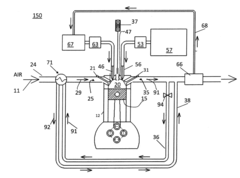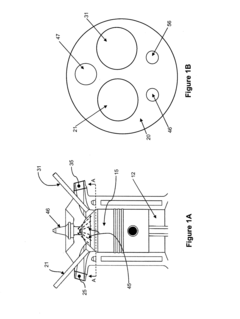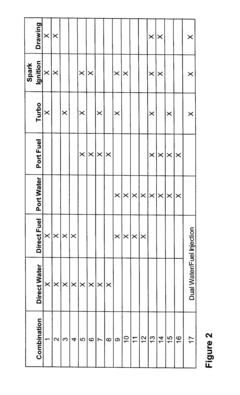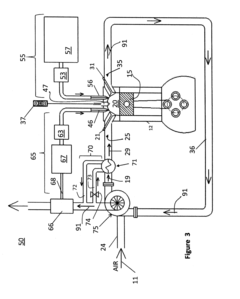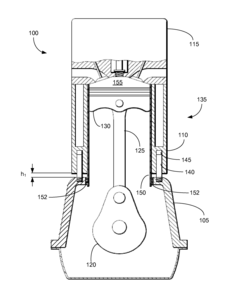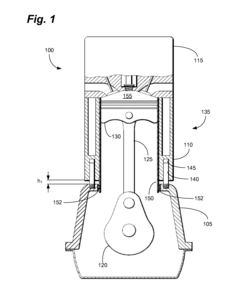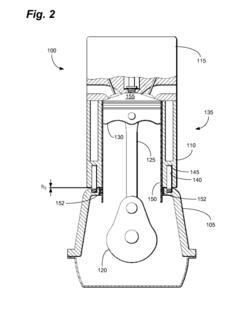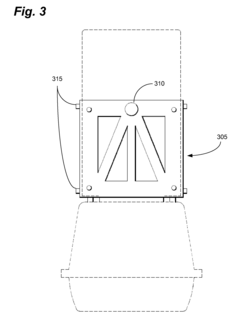V8 Engine Compression Ratio: Ideal Settings Explained
JUL 4, 20259 MIN READ
Generate Your Research Report Instantly with AI Agent
Patsnap Eureka helps you evaluate technical feasibility & market potential.
V8 Engine CR Background and Objectives
The V8 engine, a marvel of automotive engineering, has been a cornerstone of high-performance vehicles for decades. Its compression ratio (CR) plays a crucial role in determining engine efficiency, power output, and overall performance. The evolution of V8 engine compression ratios reflects the ongoing pursuit of optimal balance between power, efficiency, and reliability.
Historically, V8 engines emerged in the early 20th century, with initial compression ratios ranging from 4:1 to 6:1. As technology advanced, these ratios steadily increased, driven by the demand for greater power and efficiency. The mid-20th century saw a significant leap in compression ratios, with some high-performance V8 engines reaching 10:1 or higher. This trend was fueled by improvements in fuel quality, engine materials, and manufacturing precision.
The oil crisis of the 1970s marked a turning point, shifting focus towards fuel efficiency. This led to a temporary reduction in compression ratios as manufacturers prioritized economy over raw power. However, the advent of electronic fuel injection and engine management systems in the 1980s and 1990s allowed for a resurgence in higher compression ratios without sacrificing efficiency or emissions compliance.
In recent years, the automotive industry has faced increasing pressure to improve fuel economy and reduce emissions. This has led to a renewed focus on optimizing compression ratios in V8 engines. Modern V8 engines often feature compression ratios between 10:1 and 12:1, with some high-performance variants pushing even higher.
The primary objective in setting an ideal compression ratio for a V8 engine is to maximize thermal efficiency while avoiding issues such as pre-ignition and detonation. Higher compression ratios generally lead to improved fuel efficiency and power output. However, they also increase the risk of engine knock and require higher-octane fuel to prevent pre-ignition.
Advancements in engine design, such as direct fuel injection, variable valve timing, and cylinder deactivation, have allowed engineers to push the boundaries of compression ratios. These technologies enable precise control over the combustion process, allowing for higher compression ratios without compromising reliability or drivability.
Looking forward, the automotive industry aims to further optimize V8 engine compression ratios to meet increasingly stringent emissions regulations while maintaining the power and character that enthusiasts demand. This involves exploring innovative technologies such as variable compression ratio systems, which can dynamically adjust the compression ratio based on driving conditions and performance requirements.
Historically, V8 engines emerged in the early 20th century, with initial compression ratios ranging from 4:1 to 6:1. As technology advanced, these ratios steadily increased, driven by the demand for greater power and efficiency. The mid-20th century saw a significant leap in compression ratios, with some high-performance V8 engines reaching 10:1 or higher. This trend was fueled by improvements in fuel quality, engine materials, and manufacturing precision.
The oil crisis of the 1970s marked a turning point, shifting focus towards fuel efficiency. This led to a temporary reduction in compression ratios as manufacturers prioritized economy over raw power. However, the advent of electronic fuel injection and engine management systems in the 1980s and 1990s allowed for a resurgence in higher compression ratios without sacrificing efficiency or emissions compliance.
In recent years, the automotive industry has faced increasing pressure to improve fuel economy and reduce emissions. This has led to a renewed focus on optimizing compression ratios in V8 engines. Modern V8 engines often feature compression ratios between 10:1 and 12:1, with some high-performance variants pushing even higher.
The primary objective in setting an ideal compression ratio for a V8 engine is to maximize thermal efficiency while avoiding issues such as pre-ignition and detonation. Higher compression ratios generally lead to improved fuel efficiency and power output. However, they also increase the risk of engine knock and require higher-octane fuel to prevent pre-ignition.
Advancements in engine design, such as direct fuel injection, variable valve timing, and cylinder deactivation, have allowed engineers to push the boundaries of compression ratios. These technologies enable precise control over the combustion process, allowing for higher compression ratios without compromising reliability or drivability.
Looking forward, the automotive industry aims to further optimize V8 engine compression ratios to meet increasingly stringent emissions regulations while maintaining the power and character that enthusiasts demand. This involves exploring innovative technologies such as variable compression ratio systems, which can dynamically adjust the compression ratio based on driving conditions and performance requirements.
Market Demand for High-Performance V8 Engines
The market demand for high-performance V8 engines remains robust, driven by a combination of factors including consumer preferences, automotive industry trends, and technological advancements. In the luxury and sports car segments, V8 engines continue to be highly sought after for their power, performance, and distinctive sound characteristics. This demand is particularly strong in markets such as North America, Europe, and the Middle East, where high-performance vehicles are valued for their prestige and driving experience.
The automotive industry has witnessed a shift towards more fuel-efficient and environmentally friendly technologies, which has led to increased focus on optimizing V8 engine performance while improving fuel economy. This trend has resulted in the development of advanced V8 engines with higher compression ratios, direct injection systems, and variable valve timing, allowing manufacturers to meet stringent emissions regulations while still delivering the power output expected from V8 engines.
In the sports car market, V8 engines remain a key selling point for many manufacturers. Brands like Ferrari, Porsche, and Mercedes-AMG continue to invest in V8 technology, recognizing its appeal to enthusiasts and performance-oriented consumers. The racing industry also contributes significantly to the demand for high-performance V8 engines, with many motorsport categories still relying on V8 powerplants for their combination of power, reliability, and spectator appeal.
The luxury SUV segment has emerged as a new growth area for high-performance V8 engines. As consumers increasingly prefer larger vehicles, manufacturers have responded by offering powerful V8 options in their premium SUV lineups. This trend has helped sustain demand for V8 engines even as the overall automotive market shifts towards smaller, more efficient powertrains.
Despite the growing popularity of electric vehicles, there remains a dedicated market for high-performance internal combustion engines, particularly V8s. This demand is driven by enthusiasts who value the unique driving experience and emotional connection offered by V8-powered vehicles. As a result, many automakers are developing hybrid V8 powertrains, combining traditional V8 engines with electric motors to deliver enhanced performance while improving fuel efficiency and reducing emissions.
The aftermarket and customization sectors also contribute significantly to the demand for high-performance V8 engines. Tuning companies and performance parts manufacturers continue to develop products specifically for V8 engines, catering to consumers looking to enhance the power and performance of their vehicles.
The automotive industry has witnessed a shift towards more fuel-efficient and environmentally friendly technologies, which has led to increased focus on optimizing V8 engine performance while improving fuel economy. This trend has resulted in the development of advanced V8 engines with higher compression ratios, direct injection systems, and variable valve timing, allowing manufacturers to meet stringent emissions regulations while still delivering the power output expected from V8 engines.
In the sports car market, V8 engines remain a key selling point for many manufacturers. Brands like Ferrari, Porsche, and Mercedes-AMG continue to invest in V8 technology, recognizing its appeal to enthusiasts and performance-oriented consumers. The racing industry also contributes significantly to the demand for high-performance V8 engines, with many motorsport categories still relying on V8 powerplants for their combination of power, reliability, and spectator appeal.
The luxury SUV segment has emerged as a new growth area for high-performance V8 engines. As consumers increasingly prefer larger vehicles, manufacturers have responded by offering powerful V8 options in their premium SUV lineups. This trend has helped sustain demand for V8 engines even as the overall automotive market shifts towards smaller, more efficient powertrains.
Despite the growing popularity of electric vehicles, there remains a dedicated market for high-performance internal combustion engines, particularly V8s. This demand is driven by enthusiasts who value the unique driving experience and emotional connection offered by V8-powered vehicles. As a result, many automakers are developing hybrid V8 powertrains, combining traditional V8 engines with electric motors to deliver enhanced performance while improving fuel efficiency and reducing emissions.
The aftermarket and customization sectors also contribute significantly to the demand for high-performance V8 engines. Tuning companies and performance parts manufacturers continue to develop products specifically for V8 engines, catering to consumers looking to enhance the power and performance of their vehicles.
Current CR Challenges in V8 Engines
V8 engines, renowned for their power and performance, face several challenges in optimizing compression ratios (CR) for modern applications. One of the primary issues is balancing high compression ratios with fuel quality requirements. As manufacturers strive for increased efficiency, they must contend with the limitations of commercially available fuels, which may not always support the higher CRs desired for maximum performance.
Another significant challenge lies in managing heat and stress on engine components. Higher compression ratios generate increased temperatures and pressures within the combustion chamber, potentially leading to accelerated wear, reduced longevity, and increased risk of engine knock. Engineers must carefully consider material selection and design to mitigate these effects without compromising performance.
Emissions regulations present a further complication in CR optimization. While higher compression ratios can improve fuel efficiency, they may also lead to increased NOx emissions due to higher combustion temperatures. Striking a balance between performance, efficiency, and emissions compliance remains a constant challenge for V8 engine designers.
The pursuit of variable compression ratio technologies adds another layer of complexity. While offering the potential for adaptive performance across various operating conditions, these systems introduce additional mechanical complexity, weight, and cost considerations that must be carefully evaluated.
Cooling system design becomes increasingly critical as compression ratios rise. Adequate heat dissipation is essential to prevent overheating and maintain optimal performance, particularly in high-performance applications. This necessitates innovative cooling solutions that can effectively manage the increased thermal load without adding excessive weight or complexity to the engine package.
Fuel injection systems must also evolve to support higher compression ratios. Precise fuel delivery and atomization become even more crucial to prevent pre-ignition and ensure efficient combustion. This drives the need for advanced injection technologies and control systems capable of adapting to the demands of high-CR engines.
Lastly, the challenge of maintaining drivability and NVH (Noise, Vibration, and Harshness) characteristics at higher compression ratios cannot be overlooked. As internal pressures increase, so does the potential for increased engine vibration and noise. Engineers must employ advanced design techniques and materials to ensure that the pursuit of higher compression ratios does not come at the cost of driver comfort and vehicle refinement.
Another significant challenge lies in managing heat and stress on engine components. Higher compression ratios generate increased temperatures and pressures within the combustion chamber, potentially leading to accelerated wear, reduced longevity, and increased risk of engine knock. Engineers must carefully consider material selection and design to mitigate these effects without compromising performance.
Emissions regulations present a further complication in CR optimization. While higher compression ratios can improve fuel efficiency, they may also lead to increased NOx emissions due to higher combustion temperatures. Striking a balance between performance, efficiency, and emissions compliance remains a constant challenge for V8 engine designers.
The pursuit of variable compression ratio technologies adds another layer of complexity. While offering the potential for adaptive performance across various operating conditions, these systems introduce additional mechanical complexity, weight, and cost considerations that must be carefully evaluated.
Cooling system design becomes increasingly critical as compression ratios rise. Adequate heat dissipation is essential to prevent overheating and maintain optimal performance, particularly in high-performance applications. This necessitates innovative cooling solutions that can effectively manage the increased thermal load without adding excessive weight or complexity to the engine package.
Fuel injection systems must also evolve to support higher compression ratios. Precise fuel delivery and atomization become even more crucial to prevent pre-ignition and ensure efficient combustion. This drives the need for advanced injection technologies and control systems capable of adapting to the demands of high-CR engines.
Lastly, the challenge of maintaining drivability and NVH (Noise, Vibration, and Harshness) characteristics at higher compression ratios cannot be overlooked. As internal pressures increase, so does the potential for increased engine vibration and noise. Engineers must employ advanced design techniques and materials to ensure that the pursuit of higher compression ratios does not come at the cost of driver comfort and vehicle refinement.
Existing CR Optimization Techniques
01 Variable compression ratio in V8 engines
V8 engines can be designed with variable compression ratio systems, allowing for dynamic adjustment of the compression ratio during operation. This technology enables optimized performance and efficiency across different operating conditions, balancing power output and fuel economy as needed.- Variable compression ratio systems: V8 engines can be equipped with variable compression ratio systems that allow for dynamic adjustment of the compression ratio. This technology enables the engine to optimize performance and efficiency based on driving conditions, load, and fuel quality. The system typically involves movable components in the engine block or cylinder head to alter the combustion chamber volume.
- High compression ratio for improved efficiency: Some V8 engines are designed with higher compression ratios to increase thermal efficiency and power output. This approach often requires the use of high-octane fuel and advanced engine management systems to prevent knocking. The higher compression ratio can lead to improved fuel economy and reduced emissions when properly implemented.
- Combustion chamber design optimization: The shape and design of the combustion chamber in V8 engines play a crucial role in determining the compression ratio and overall engine performance. Engineers focus on optimizing the chamber geometry, piston crown design, and valve positioning to achieve the desired compression ratio while maintaining efficient combustion and flame propagation.
- Turbocharging and compression ratio balance: In turbocharged V8 engines, the compression ratio is often lowered compared to naturally aspirated engines to accommodate the increased pressure from forced induction. This balance helps prevent detonation while still allowing for significant power gains. Advanced engine management systems and materials are used to optimize the compression ratio for turbocharged applications.
- Compression ratio adjustment mechanisms: Some V8 engines incorporate mechanical or hydraulic systems that allow for compression ratio adjustment. These mechanisms can alter the piston's top dead center position or the cylinder head's position relative to the block. This technology enables engines to adapt to different operating conditions and fuel types, optimizing performance and efficiency across various scenarios.
02 High compression ratio for improved efficiency
Increasing the compression ratio in V8 engines can lead to improved thermal efficiency and fuel economy. However, this approach requires careful consideration of factors such as fuel quality, engine materials, and cooling systems to prevent issues like knocking and engine damage.Expand Specific Solutions03 Compression ratio optimization for performance
Optimizing the compression ratio in V8 engines involves balancing power output, fuel efficiency, and emissions. This can be achieved through advanced piston designs, cylinder head configurations, and combustion chamber shapes, resulting in improved overall engine performance.Expand Specific Solutions04 Compression ratio control in turbocharged V8 engines
Turbocharged V8 engines often require lower compression ratios to accommodate the increased pressure from forced induction. Implementing advanced compression ratio control systems can help manage boost pressure and compression ratio to optimize performance and prevent engine damage.Expand Specific Solutions05 Materials and design for high compression ratio V8 engines
Developing V8 engines with high compression ratios requires the use of advanced materials and design techniques. This includes employing heat-resistant alloys, improved cooling systems, and precision manufacturing processes to ensure engine durability and reliability under increased compression pressures.Expand Specific Solutions
Key V8 Engine Manufacturers and Competitors
The V8 engine compression ratio market is in a mature stage, with established players and ongoing innovation. The global automotive engine market size is substantial, expected to reach $86.11 billion by 2027. Technologically, compression ratio optimization is well-understood but continues to evolve with advancements in materials and design. Major automotive manufacturers like Ford, GM, Toyota, and Honda are at the forefront, constantly refining their V8 engines for improved performance and efficiency. Research institutions such as Southwest Research Institute and universities like Tongji University contribute to pushing the boundaries of compression ratio technology, collaborating with industry leaders to develop next-generation solutions.
Ford Global Technologies LLC
Technical Solution: Ford has developed EcoBoost technology, which combines direct fuel injection, turbocharging, and variable valve timing to optimize compression ratios. Their latest 1.5L EcoBoost engine achieves a compression ratio of 11:1, balancing performance and efficiency[1]. Ford's research focuses on dynamic compression ratio adjustment, allowing the engine to adapt to different driving conditions. They've implemented a dual-fuel system that can switch between high octane fuel for performance and regular fuel for efficiency, enabling compression ratios up to 13:1 without knock issues[2]. Ford is also exploring variable compression ratio technologies, aiming to achieve a range of 8:1 to 14:1 within a single engine design[3].
Strengths: Advanced EcoBoost technology, dynamic compression ratio adjustment, and dual-fuel system capabilities. Weaknesses: Complexity of systems may increase manufacturing costs and potential reliability concerns.
GM Global Technology Operations LLC
Technical Solution: GM has developed the Dynamic Fuel Management (DFM) system, which works in conjunction with variable compression ratio technology. Their latest V8 engines feature compression ratios of up to 11.5:1, utilizing advanced combustion chamber designs and direct injection[4]. GM's research focuses on cylinder deactivation technology that can seamlessly switch between 17 different firing patterns, optimizing compression ratios for various load conditions. They've also implemented a thermal management system that allows for higher compression ratios by precisely controlling engine temperatures[5]. GM is exploring the use of Miller cycle in conjunction with variable compression, potentially achieving effective compression ratios of up to 14:1 in their upcoming engine designs[6].
Strengths: Advanced cylinder deactivation technology, thermal management systems, and integration of Miller cycle. Weaknesses: Complexity of DFM system may lead to increased maintenance requirements.
Innovative CR Technologies for V8 Engines
Internally cooled high compression lean-burning internal combustion engine
PatentActiveUS20160076440A1
Innovation
- The implementation of a system that operates spark or compression-ignition engines at elevated compression ratios using lean air-fuel ratios and liquid water injection to control cylinder temperatures, reducing the need for external cooling and enhancing thermal efficiency.
Variable Compression Ratio Engine
PatentActiveUS20150260093A1
Innovation
- A system utilizing hollow head bolts and control bolts to mechanically couple the cylinder head and block, allowing vertical movement relative to the crankcase while constraining movement in other directions, enabling the engine to switch between high and low compression ratios using mechanical, electrical, or hydraulic devices.
Emissions Regulations Impact on V8 CR
Emissions regulations have significantly impacted the development and optimization of V8 engine compression ratios (CR) in recent years. As governments worldwide implement stricter environmental policies, automakers have been compelled to adapt their engine designs to meet these new standards. The compression ratio, a critical factor in engine efficiency and performance, has become a focal point for engineers seeking to balance power output with reduced emissions.
The introduction of Euro 6 and Tier 3 emissions standards in Europe and the United States, respectively, has led to a shift in V8 engine design philosophy. These regulations have set more stringent limits on nitrogen oxides (NOx), carbon monoxide (CO), and particulate matter emissions. As a result, manufacturers have had to reconsider traditional high-compression ratio designs that, while efficient, tend to produce higher levels of NOx due to increased combustion temperatures.
To address these challenges, engineers have explored various strategies for optimizing V8 compression ratios. One approach has been the implementation of variable compression ratio (VCR) technology. This innovative solution allows engines to dynamically adjust their compression ratio based on driving conditions, effectively balancing performance and emissions compliance. Infiniti's VC-Turbo engine, although not a V8, demonstrates the potential of this technology in meeting emissions targets while maintaining performance.
Another strategy has been the adoption of direct fuel injection systems in conjunction with carefully tuned compression ratios. This combination allows for more precise fuel delivery and combustion control, reducing emissions while maintaining power output. Many modern V8 engines now feature compression ratios in the range of 10:1 to 12:1, striking a balance between efficiency and emissions compliance.
The push for lower emissions has also led to the increased use of forced induction in V8 engines. Turbocharging and supercharging allow manufacturers to maintain power output with smaller displacement engines, which can operate at lower compression ratios to reduce NOx emissions. This trend has resulted in a shift from naturally aspirated V8s with higher compression ratios to forced induction V8s with more moderate ratios.
As emissions regulations continue to evolve, the future of V8 engines and their compression ratios remains uncertain. Some manufacturers are exploring the integration of hybrid systems with V8 engines, using electric motors to supplement power and allow for lower compression ratios and reduced emissions during certain driving conditions. Others are investigating advanced combustion technologies, such as homogeneous charge compression ignition (HCCI), which could potentially allow for higher compression ratios while still meeting emissions standards.
The introduction of Euro 6 and Tier 3 emissions standards in Europe and the United States, respectively, has led to a shift in V8 engine design philosophy. These regulations have set more stringent limits on nitrogen oxides (NOx), carbon monoxide (CO), and particulate matter emissions. As a result, manufacturers have had to reconsider traditional high-compression ratio designs that, while efficient, tend to produce higher levels of NOx due to increased combustion temperatures.
To address these challenges, engineers have explored various strategies for optimizing V8 compression ratios. One approach has been the implementation of variable compression ratio (VCR) technology. This innovative solution allows engines to dynamically adjust their compression ratio based on driving conditions, effectively balancing performance and emissions compliance. Infiniti's VC-Turbo engine, although not a V8, demonstrates the potential of this technology in meeting emissions targets while maintaining performance.
Another strategy has been the adoption of direct fuel injection systems in conjunction with carefully tuned compression ratios. This combination allows for more precise fuel delivery and combustion control, reducing emissions while maintaining power output. Many modern V8 engines now feature compression ratios in the range of 10:1 to 12:1, striking a balance between efficiency and emissions compliance.
The push for lower emissions has also led to the increased use of forced induction in V8 engines. Turbocharging and supercharging allow manufacturers to maintain power output with smaller displacement engines, which can operate at lower compression ratios to reduce NOx emissions. This trend has resulted in a shift from naturally aspirated V8s with higher compression ratios to forced induction V8s with more moderate ratios.
As emissions regulations continue to evolve, the future of V8 engines and their compression ratios remains uncertain. Some manufacturers are exploring the integration of hybrid systems with V8 engines, using electric motors to supplement power and allow for lower compression ratios and reduced emissions during certain driving conditions. Others are investigating advanced combustion technologies, such as homogeneous charge compression ignition (HCCI), which could potentially allow for higher compression ratios while still meeting emissions standards.
Fuel Efficiency vs Performance Trade-offs
The compression ratio of a V8 engine plays a crucial role in determining the balance between fuel efficiency and performance. This trade-off is a fundamental consideration for engine designers and automotive manufacturers, as they strive to meet increasingly stringent fuel economy standards while still delivering the power and performance expected from V8 engines.
Higher compression ratios generally lead to improved fuel efficiency. As the compression ratio increases, the combustion chamber volume decreases, resulting in a more complete burn of the air-fuel mixture. This more efficient combustion process extracts more energy from the fuel, translating to better fuel economy. Additionally, higher compression ratios can lead to increased thermal efficiency, further improving overall engine efficiency.
However, the pursuit of fuel efficiency through higher compression ratios comes with potential drawbacks in terms of performance. As compression ratios increase, the engine becomes more susceptible to knock or pre-ignition, particularly when using lower octane fuels. This can limit the engine's power output and potentially cause damage if not properly managed. To mitigate these risks, manufacturers may need to implement more advanced fuel injection systems, cooling technologies, or even reduce the engine's power output.
On the performance side, lower compression ratios often allow for greater power potential, especially in forced induction applications. Lower compression ratios provide more room for boost pressure in turbocharged or supercharged engines, enabling higher power outputs. This is particularly relevant for high-performance V8 engines used in sports cars and racing applications, where maximum power is prioritized over fuel efficiency.
The ideal compression ratio for a V8 engine depends on its intended application and the priorities of the manufacturer and end-user. For everyday passenger vehicles, a moderate compression ratio that balances fuel efficiency and performance is often preferred. In contrast, high-performance vehicles may opt for lower compression ratios to accommodate forced induction and achieve higher power outputs.
Advancements in engine technology, such as variable compression ratio systems, are beginning to bridge the gap between fuel efficiency and performance. These innovative solutions allow engines to dynamically adjust their compression ratios based on driving conditions, potentially offering the best of both worlds. However, such systems add complexity and cost to engine design and manufacturing.
In conclusion, the trade-off between fuel efficiency and performance in V8 engines, as influenced by compression ratio, remains a critical consideration in engine design. As technology evolves and environmental regulations become more stringent, finding the optimal balance will continue to be a key challenge for automotive engineers and manufacturers.
Higher compression ratios generally lead to improved fuel efficiency. As the compression ratio increases, the combustion chamber volume decreases, resulting in a more complete burn of the air-fuel mixture. This more efficient combustion process extracts more energy from the fuel, translating to better fuel economy. Additionally, higher compression ratios can lead to increased thermal efficiency, further improving overall engine efficiency.
However, the pursuit of fuel efficiency through higher compression ratios comes with potential drawbacks in terms of performance. As compression ratios increase, the engine becomes more susceptible to knock or pre-ignition, particularly when using lower octane fuels. This can limit the engine's power output and potentially cause damage if not properly managed. To mitigate these risks, manufacturers may need to implement more advanced fuel injection systems, cooling technologies, or even reduce the engine's power output.
On the performance side, lower compression ratios often allow for greater power potential, especially in forced induction applications. Lower compression ratios provide more room for boost pressure in turbocharged or supercharged engines, enabling higher power outputs. This is particularly relevant for high-performance V8 engines used in sports cars and racing applications, where maximum power is prioritized over fuel efficiency.
The ideal compression ratio for a V8 engine depends on its intended application and the priorities of the manufacturer and end-user. For everyday passenger vehicles, a moderate compression ratio that balances fuel efficiency and performance is often preferred. In contrast, high-performance vehicles may opt for lower compression ratios to accommodate forced induction and achieve higher power outputs.
Advancements in engine technology, such as variable compression ratio systems, are beginning to bridge the gap between fuel efficiency and performance. These innovative solutions allow engines to dynamically adjust their compression ratios based on driving conditions, potentially offering the best of both worlds. However, such systems add complexity and cost to engine design and manufacturing.
In conclusion, the trade-off between fuel efficiency and performance in V8 engines, as influenced by compression ratio, remains a critical consideration in engine design. As technology evolves and environmental regulations become more stringent, finding the optimal balance will continue to be a key challenge for automotive engineers and manufacturers.
Unlock deeper insights with Patsnap Eureka Quick Research — get a full tech report to explore trends and direct your research. Try now!
Generate Your Research Report Instantly with AI Agent
Supercharge your innovation with Patsnap Eureka AI Agent Platform!
